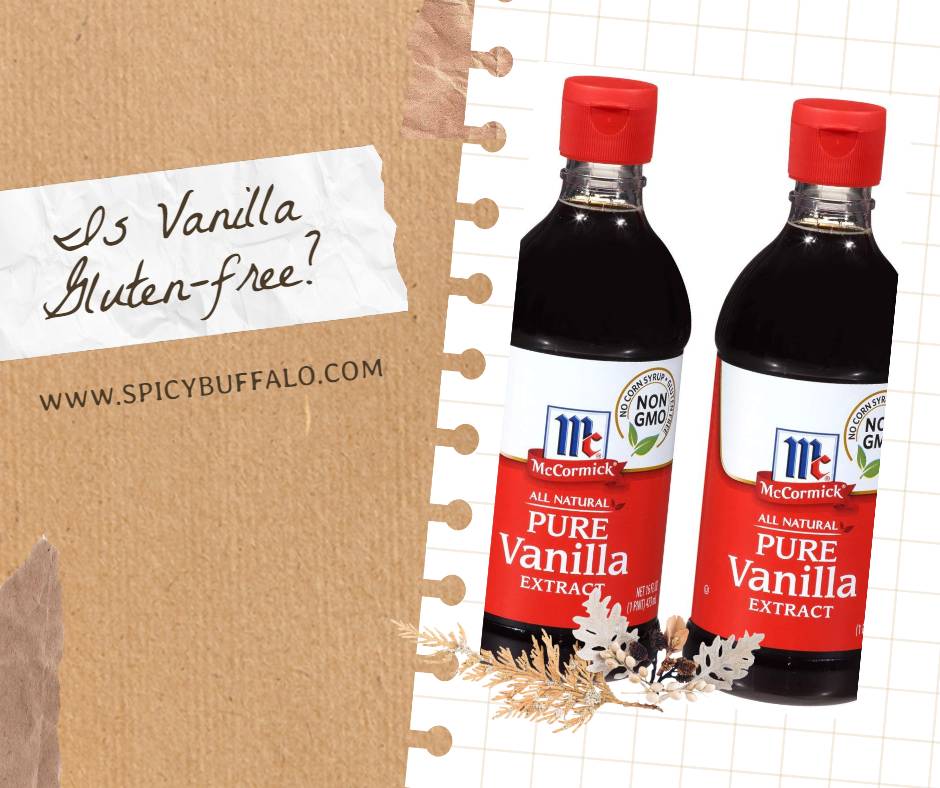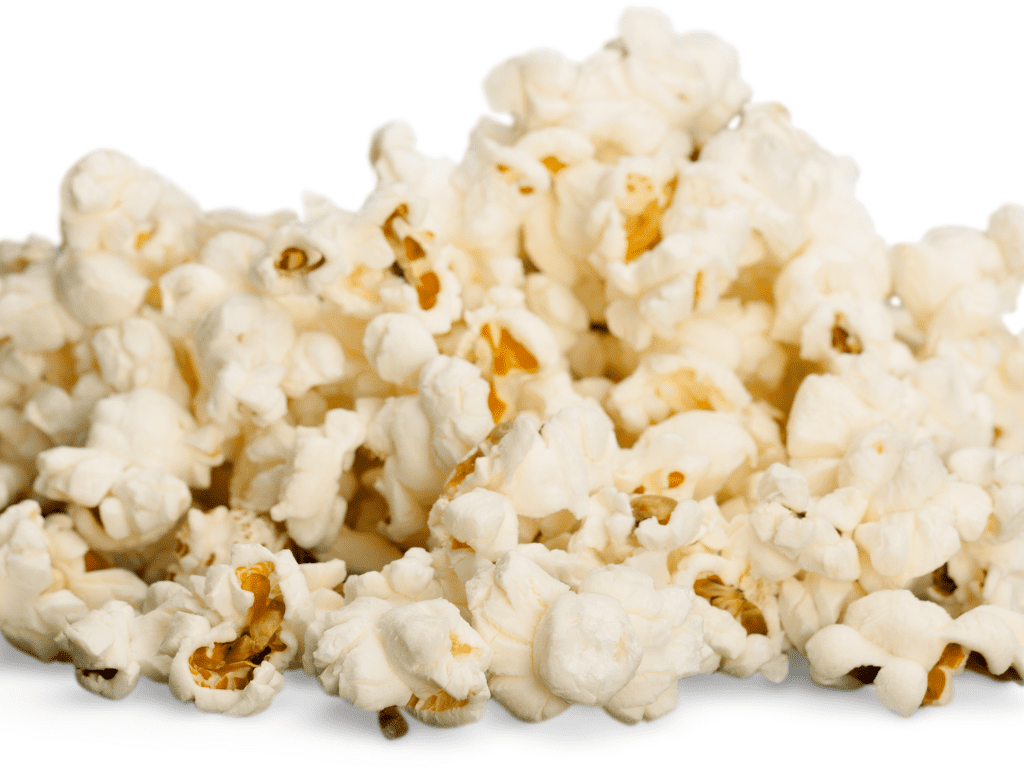
Both vanilla extract and natural vanilla flavor are safe for those on the gluten-free diet. Even though to make each product, vanilla beans are soaked in water and alcohol, it is considered gluten-free. However, this was not known until just a few short years ago.
That is why you’ll often see in gluten-free cookbooks and on gluten-free recipes sites, the term vanilla with “gluten-free” before or after it. The truth is that no vanilla – extracts or otherwise – contain gluten. Imitation and artificial vanilla extract are also gluten-free, though niether is nearly as good as the real thing.
McCormick recently began labeling their pure vanilla extract gluten-free, even though it always was gluten-free. There is no gluten-free product list on the company’s website which is annoying since they have started labeling at least the vanilla extract gluten-free.
McCormick, like so many other companies, realized that some people will choose an item that is marked gluten-free over others that are not, when given the opportunity. However, there are less expensive vanilla extracts than the McCormick brand.
In Shelley Case’s book “Gluten-Free Diet: A Comprehensive Resource Guide”, vanilla, vanilla extract, vanilla flavoring and vanillin are all listed in the gluten-free additive and ingredients list.
It’s again confusing for someone new to the diet who might pick up a gluten-free cookbook at the library where every reference to vanilla calls for a gluten-free version. That would indicate there might be a gluten containing version of vanilla out there somewhere.
While it’s frustrating that for so long, very little was known about what was and was not gluten-free – at least in terms of many processed foods – the safest thing to do is rely on factual information from nutrition experts like Shelley Case.
She has devoted much of her dietitian career to helping those in our community safely follow the gluten-free diet. Vanilla is gluten-free so buy whatever brand of it you want to. It matters not if ‘gluten-free’ stamped on the box or not.
Vanilla extract is one of the most common ingredients in many baked goods today. There are few dessert and sweet tweet recipes that you’ll be able to find that don’t call for this delicious flavoring.
It’s for a good reason that vanilla extract is so popular too – it adds a flavor you just can’t get from any other ingredient. It’s rich, sweet smelling (without being sweet), and smells like a warm hug (I’m channeling my inner Olaf here).
Vanilla is such a common ingredient, you may not even consider how it fits into a gluten-free diet, because it’s so pervasive.
Just like any other ingredient and food, it’s important to do your due diligence and find out that every ingredient that goes into your mouth is safe for your gluten-free diet if you avoid it for health reasons.
Vanilla is so common in baked goods – homemade and store bought – that it’s a good idea to do some research and know what’s safe before continuing on cooking and baking with it.
In this post, we’re going to dive deep into the topic of vanilla extract and find out what vanilla is, what it’s made from, and if vanilla extract is gluten-free.
We’ll also learn about imitation vanilla and vanilla flavoring, discuss why vanilla extract is so expensive, and finally what brands are safe for a gluten-free diet. Let’s learn out about everyone’s favorite baking ingredient!
Vanilla extract is an ingredient made from steeping vanilla bean pods and seeds in alcohol and water.
It is used in many baking recipes and provides a very rich flavor and smell that many folks associate with homemade treats. Vanilla can also be used in savory dishes, but it is most commonly found in cakes, cookies, puddings, and sweets.
Vanilla extract is made from the beans of a tropical orchid that is native to Mexico, but is now grown in various parts of the world, like Madagascar, Central America, Africa, and the South Pacific.
Vanilla beans are cured, then ground into small pieces, then added to alcohol or water to extract the flavor from the vanilla beans and pods.
Some manufacturers make their vanilla extract slowly by allowing the flavors of vanilla to be extracted into the alcohol over a long period of time. Others try to speed this process up by using heat, but the flavor is often compromised when this method is used.
Vanilla extract is generally made from just vanilla beans and seeds and alcohol or water.
Gluten is a protein found in most wheat products, and acts as the “glue” that helps to hold wheat, barley, kamut, spelt, farro, durum, bulgur, rye, and semolina together to maintain their shape.
You can find gluten in whole grains, but also in many processed foods as well. If you purchase wheat bread, there will be gluten in it, because wheat by nature has gluten.
Many processed foods have hidden gluten in them in the form or gluten or wheat derivatives. These are also in the form of flavorings, binders to keep ingredients together, or other additives.
Since alcohol or water is gluten-free, and vanilla beans are naturally gluten-free, we can say with certainty that pure vanilla extract is gluten-free and safe for a gluten-free diet.
Imitation vanilla is not the same as vanilla extract. This product is created from synthetic vanillin from other plant fibers – not the tropical orchids that make real vanilla beans.
Vanilla flavoring is a blend of pure vanilla extract and imitation vanilla.
Imitation vanilla and vanilla flavoring, even though they’re not the same as real vanilla extract, are also likely to be gluten-free. As with any food, it’s best to look for a product with a gluten-free label if you’re concerned about gluten being present.
Pure vanilla extract is expensive, because the ingredients to make it are rare and the time it takes to grow vanilla beans and extract them isn’t quick.
The process of growing and making vanilla extract is a big waiting game, so manufacturers boost prices, knowing there is demand for the product.
While vanilla extract can be on the pricey side, you get what you pay for. Pure vanilla extract is leaps and bounds better flavorwise compared to imitation vanilla or vanilla flavoring.
The nuanced flavor that comes from the real deal pure vanilla extract will come through in all your recipes. It is worth the extra money to get a good quality vanilla!
Which brands of vanilla extract are gluten free?
Two of the most popular brands of vanilla extract are House Foods and Nielsen-Massey.
The reason it’s difficult to find a gluten-free vanilla extract is because these two companies make almost all of the vanilla extract in the country, so they must find a way to insure that there will be enough stock and product to satisfy demand.
While these brands are gluten-free, not all of their products are. It’s easy to see on their website, but only if you know what you’re looking for. For example, a company like Nielsen-Massey does not have a Gluten Free tag on their website for their gluten-free products.
It’s important to know what you’re looking for, and know where to look for it.
House Foods is a large company that makes a variety of different products, but they believe in following the guidelines set by the FDA when it comes to labeling gluten-free foods and ingredients.
Is McCormick vanilla flavor same as vanilla extract?
McCormick is one of the largest and best-known food companies in the country. They have been around for over a century, and their products are very popular among home cooks and bakers.
It’s likely that McCormick makes some gluten-free vanilla extract, but they only label their products as natural flavors or extracts, so there’s no telling what is or isn’t gluten-free.
Be sure to read the ingredients on your particular McCormick product to find out if it is safe for your diet.
Vanilla Beans or Extract?
Vanilla beans are packed with flavor, and can be used in recipes that call for real vanilla extract. They aren’t as convenient as a bottle of vanilla extract, but if you want to take the time to make your own vanilla extract, using real vanilla beans is the way to go.
How can I make my own Vanilla Extract?
If you’d like to make your own homemade vanilla extract, here is an easy recipe that will give you a delicious homemade product in a matter of days! Wash 4 whole Madagascar vanilla beans, then split each bean down the center lengthwise with a sharp paring knife.
Is vanilla powder gluten free?
Vanilla powder is another way of adding vanilla flavor to recipes. Vanilla powder is made by grinding up real vanilla beans, then adding them to a powdered sugar mixture.
This blend is sweet and very easy to use, especially in drinks and desserts. This can be added a drop at time for that hint of vanilla flavor without the liquid. I like to use this in my favorite cupcake recipe.
It’s important that you make sure your vanilla powder or extract is gluten-free if you have celiac disease or non-celiac gluten sensitivity, because some manufacturers may add wheat or barley flour to help the mixture stick together better during the grinding process.
Why is vanilla not gluten free?
Vanilla is a flavoring derived from the pods of the vanilla orchid. This plant is grown in tropical climates and are harvested by hand.
The pods are scraped and the beans inside are removed and dried. The beans are then fermented, rolled, dried, and packaged to sell. Because of how this process works, vanilla isn’t gluten-free because it comes from a plant that is grown in a place that isn’t known for its ability to avoid cross-contamination with wheat or other gluten containing grains.
Does imitation vanilla extract have gluten?
An immediate answer to the question of “is imitation vanilla gluten free” is that it depends on the brand that you purchase. Many products do not make a distinction between imitation vanilla extract and pure vanilla extract, and may only use “vanilla” as part of the product name, which could mean either ingredient.
If you purchase an imitation vanilla flavor or extract, it may have been sourced from wheat due to cross-contamination or from a base that is made from ingredients derived from wheat or barley. It is important to check the packaging for the ingredients in your product.
Vanilla is a highly desired flavoring in baking and cooking. You can use vanilla extract or vanilla beans to add that special touch of flavor to your recipes.
Because real vanilla beans are expensive, you might want to look for one that uses real vanilla beans rather than an imitation flavoring. There is no reason why you can’t put both ingredients into your favorite recipes!
Most recipes call for pure vanilla extract, while other recipes require the use of imitation flavors that contain regular table sugar or artificial flavorings. The flavor of the imitation flavoring will come through much more strongly than the original ingredient, which means it would be fine to substitute the imitation flavoring with pure vanilla in those cases.













